
Browse an alphabetical list of photographs. These historical images portray people, places, and events before, during, and after World War II and the Holocaust.
<< Previous | Displaying results 2001-2025 of 2641 for "Photo" | Next >>
Hitler reviews a parade celebrating the reintegration of the Saar region into Germany. Saar territory, Germany, March 1935.
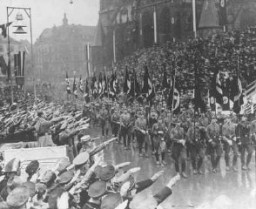
Abraham Kaplan and his wife Maria at their home in Paterson, New Jersey. He was the half brother of Blanka's grandmother. Blanka lived with Abraham and Maria when she came to the United States. She loved them dearly.
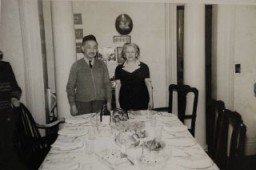
Soon after liberation, camp survivors bathe in outdoor showers set up by the British. Bergen-Belsen, Germany, after April 15, 1945.
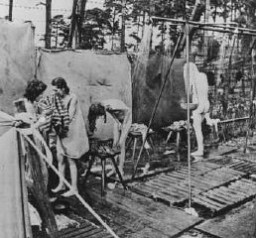
Relief supplies in a refugee camp in eastern Chad for refugees from the Darfur region of neighboring Sudan. Jerry Fowler, Staff Director of the Museum's Committee on Conscience, visited in May 2004 to hear firsthand the refugees' accounts of the genocidal violence they faced and of being driven into the desert.
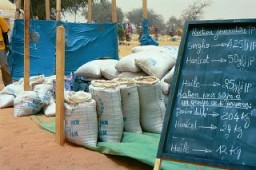
The remains of a crematorium at the Bergen-Belsen concentration camp. This photograph was taken after the liberation of the camp in 1945. Bergen-Belsen, Germany, date uncertain.

The last remaining wall of the Boerneplatz synagogue, destroyed during the Kristallnacht ("Night of Broken Glass") pogrom. Onlookers watch during the dismantling and removal of remnants of the synagogue. Frankfurt am Main, Germany, January, 1939.
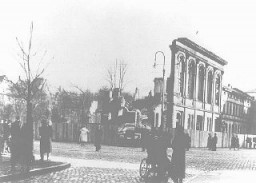
During the remilitarization of the Rhineland, German civilians salute German forces crossing the Rhine River in open violation of the Treaty of Versailles. Mainz, Germany, March 7, 1936.
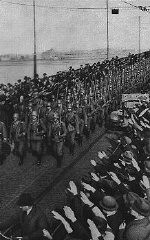
The remodeled courtroom at Nuremberg, site of the International Military Tribunal. Germany, November 15-20, 1945.
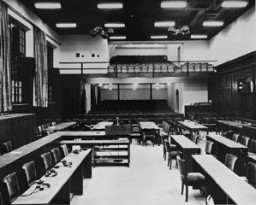
View during the remodeling of the Palace of Justice in Nuremberg in preparation for the International Military Tribunal. Nuremberg, Germany, 1945.
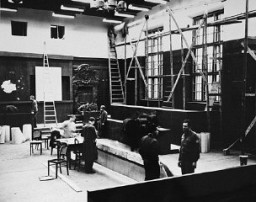
British soldiers supervise the transfer of refugees from the Exodus 1947 to deportation ships which will take them to France. Haifa, Palestine, July 20, 1947.
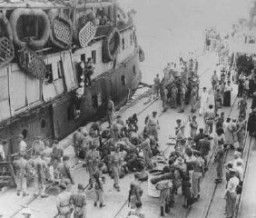
Repairs and improvements are made to the courtroom where the International Military Tribunal trial of war criminals would be held. The holes in the walls at the top (when completed) housed radio commentators and public address operators. September 11, 1945.
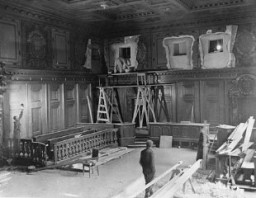
Representatives of four states who ratified the Genocide Convention on October 14, 1950. Seated from left to right: Dr. John P. Chang (Korea), Dr. Jean Price-Mars (Haiti), Assembly President Amb. Nasrollah Entezam (Iran), Amb. Jean Chauvel (France), Mr. Ruben Esquivel de la Guardia (Costa Rica), (standing, left to right) Dr. Ivan Kerno (Asst. Secretary General for Legal Affairs), Mr. Trygve Lie (Secretary-General of U.N.), Mr. Manuel A. Fournier Acuna (Costa Rica), and Dr. Raphael Lemkin (crusader for the…
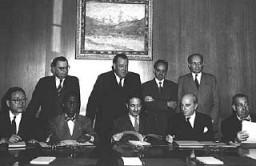
Dr. Joseph Jaksy poses with (from left to right) Valeria Suran, Lydia Suran, and his wife. The Suran sisters were among 25 Jews Dr. Jaksy rescued during the war. Czechoslovakia, date uncertain.
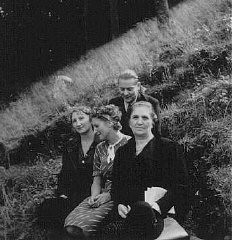
Dr. Joseph Jaksy (right) and a colleague. Dr. Jaksy, a Lutheran and a urologist in Bratislava, saved at least 25 Jews from deportations. He was later recognized as "Righteous Among the Nations." Bratislava, Czechoslovakia, prewar.
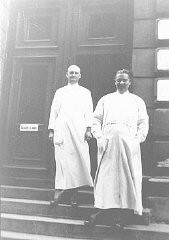
Father Bruno with Jewish children he hid from the Germans. Yad Vashem recognized Father Bruno as "Righteous Among the Nations." Belgium, wartime.
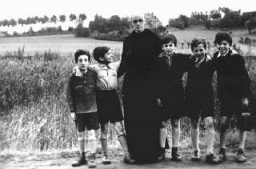
Stefania Podgorska (right), pictured here with her younger sister Helena (left), helped Jews survive in German-occupied Poland. She supplied food to Jews in the Przemysl ghetto. Following the German destruction of the ghetto in 1943, she saved 13 Jews by hiding them in her attic. Przemysl, Poland, 1944.
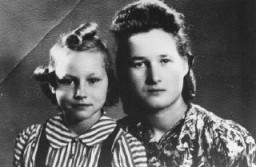
Onlookers watch during the resettlement of Romani (Gypsy) families from Vienna. Austria, September–December 1939.
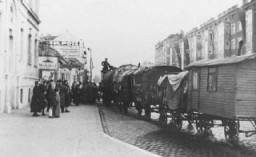
Members of a resistance organization in the camp meet with American soldiers in front of the entrance to the Buchenwald concentration camp. Buchenwald, Germany, after April 11, 1945. In early April 1945, as US forces approached the camp, the Germans began to evacuate some 28,000 prisoners from the main camp and an additional several thousand prisoners from the subcamps of Buchenwald. About a third of these prisoners died from exhaustion en route or shortly after arrival, or were shot by the SS. The…
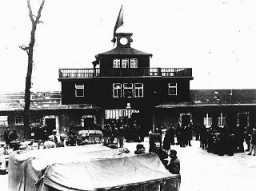
Shortly before liberation by Allied forces, French resistance fighters staged uprisings across occupied France. Here, fighters gather arms during the Marseille uprising. Marseille, France, August 1944.
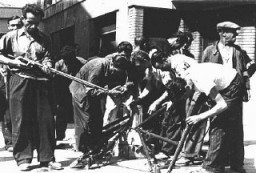
Adolf Hitler, Julius Streicher (foreground, right), and Hermann Göring (left of Hitler) retrace the steps of the 1923 Beer Hall Putsch (coup). Munich, Germany, November 9, 1934.
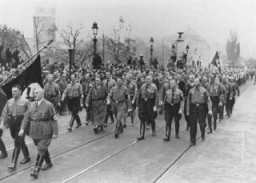
Belgian officials at the gangplank of the St. Louis after the ship was forced to return to Europe from Cuba. Belgium granted entry to some of the passengers. Antwerp, Belgium, June 1939.
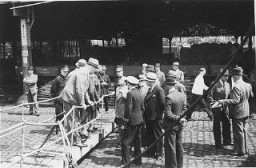
Belgium agreed to accept some of the Jewish refugee passengers of the St. Louis after Cuba and the US denied them entry. Here, Belgian police escort some of the passengers after their arrival in Antwerp. Belgium, June 17, 1939.
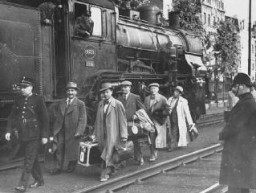
The St. Louis, carrying German Jewish refugees denied entry into Cuba and the United States, arrives in Antwerp. Belgian police guard the gangway to prevent passengers' relatives from boarding the ship. Belgium, June 17, 1939.
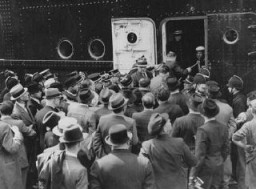
September 1, 1944, Richard Baer ceremonially accepts a copy of the construction plans from the Chief of the Central Construction Directorate of the Waffen SS, SS-Sturmbannführer Karl Bischoff, celebrating the opening of an SS military hospital (SS-Lazarette). Baer was the last commandant of the Auschwitz camp. From Karl Höcker's photograph album, which includes both documentation of official visits and ceremonies at Auschwitz as well as more personal photographs depicting the many social…
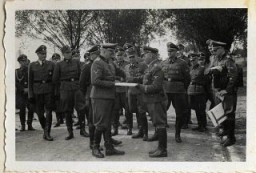
Richard Baer, Dr. Josef Mengele, and Rudolf Höss. From Karl Höcker's photograph album, which includes both documentation of official visits and ceremonies at Auschwitz as well as more personal photographs depicting the many social activities that he and other members of the Auschwitz camp staff enjoyed. These rare images show Nazis singing, hunting, and even trimming a Christmas tree. They provide a chilling contrast to the photographs of thousands of Hungarian Jews deported to Auschwitz at the same…
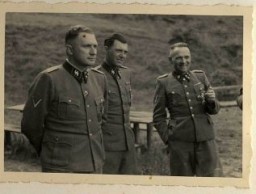
We would like to thank Crown Family Philanthropies, Abe and Ida Cooper Foundation, the Claims Conference, EVZ, and BMF for supporting the ongoing work to create content and resources for the Holocaust Encyclopedia. View the list of donor acknowledgement.